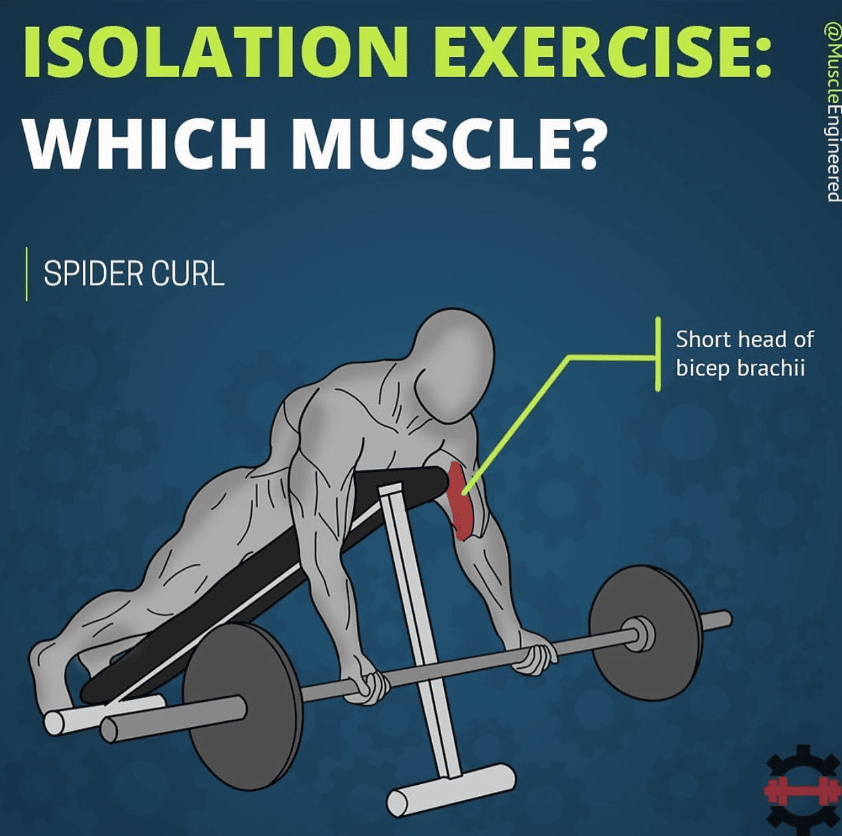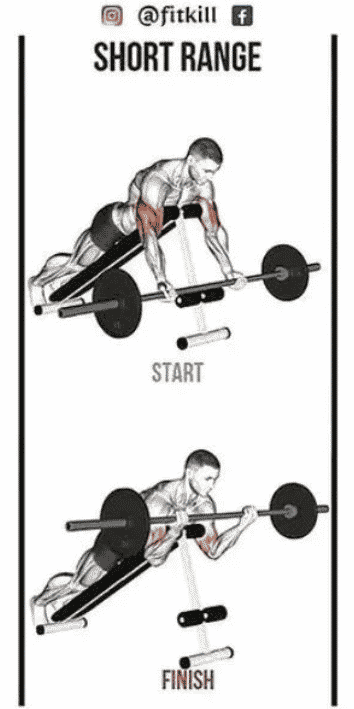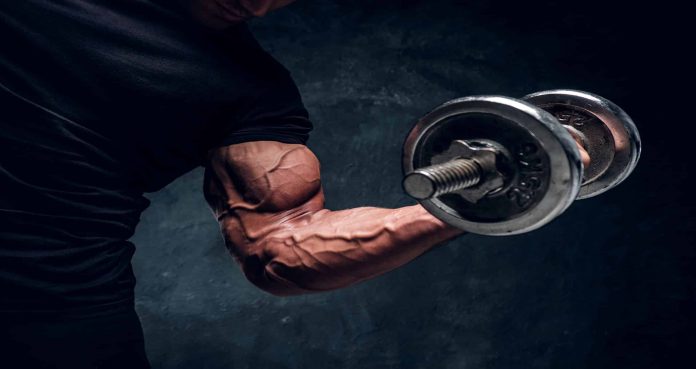An effective exercise to help blow your biceps up
Biceps. A favorite muscle to train amongst almost all gym goers. Who doesn’t enjoy a good bicep pump? Barbell curls, preacher curls, cable curls; they are all effective movements to blow up your biceps. However, after a while you’re going to want to throw in something different that can make those biceps really pop. What should it be?
Enter…the spider curl. One of the simplest, yet one of the most effective curl variations you can utilize for your biceps. Spider curls are a movement that provides a great contraction and amazing tension throughout the movement, making it a great exercise to build those peaks.
In this article we will cover just exactly how to properly perform spider curls, how they work, training tips, and if you should be throwing this all time classic exercise into your workouts. Additionally we’ll be answering some FAQs to help you get the most out of your biceps!
Editor’s Note: Generation Iron’s content is meant to be informative and should not take the place of advice and/or supervision from a medical professional/trainer. The articles and opinions on this site are not meant to be used as diagnosis, prevention, and/or treatment of health problems. Speak with your physician/trainer if you have any concerns.
How to Do Spider Curls
While spider curls are indeed a rather simple exercise to execute, there are some things to keep in mind as far as doing them properly in order to maximize the benefits.
The Tools
Spider curls can be done in a variety of different ways, all effective, which is what makes it such a useful exercise. All you need is an incline bench, and something to curl. The movement can be completed using an incline bench with dumbbells, an EZ bar, a barbell, or even cables!
Setting up for Spider Curls
- For setting up this exercise, begin by adjusting the incline bench on a slight angle
- Typically a 45 or 60 degree angle works great
- Grab whatever you are using to curl; again you can choose from dumbbells, barbells, EZ bar, or cable attachments, all while using an underhand grip
- Lie on the bench with your torso and stomach pressed against the backrest (The top of the bench should be at armpit length)
- Keep shoulders and upper arms locked in place, with the forearms being the only part of the arm moving through the bending of the elbows
- Curl towards your shoulders, squeezing the biceps throughout the whole movement and hold the contraction at the top of the movement. Make sure to really focus on that squeeze
- In a controlled manner, lower the weight back to your initial starting point
- Repeat this for your targeted rep range
See the Pro use it: To see some spider curls in action, check out this video from 4x Mr. Olympia Champ, Jay Cutler:
Sets and Reps
Due to spider curls being an isolation movement for a relatively smaller muscle group, it is not an exercise you will want to go too heavy on. You do not want to be hitting one rep PRs or sets of low reps. Instead you want to do this movement with moderate weight and higher reps to maximize hypertrophy.
Aim for 3-5 sets of 12-15 reps. Really get the most out of each rep, focusing on good control on the way up, a tight squeeze at the top, and extending the bicep back down slowly.
Training Tip: When using cables for your spider curls, you can use a variety of attachments such as a straight bar, D-Handle, or rotating curl bar (shaped like an EZ bar)
Benefits of Spider Curls
So…what does this movement have over other bicep movements? For starters, it is a great bicep isolation exercise that keeps the muscle under constant tension. The way the lifter is positioned makes it hard for them to cheat the rep up, making this exercise really tear up the biceps.
Another reason this movement is beneficial is the range of motion. Unless you have abnormally long arms or your incline bench is too low to the floor, you will get a full range of motion with each rep.
Muscles Targeted
The biceps brachii are the main muscles worked within this exercise. You are targeting both the long head and the short head of the biceps.
The spider curl also hits secondary muscle groups, these include the brachioradialis, brachialis, and forearms as well. The forearms and grip strength also come largely into play once the biceps start to fatigue.

Variety
As stated before, spider curls can be performed with a number of different pieces of equipment. This includes barbells, dumbbells, or cable attachments. This is another reason the spider curl is an exercise that can easily be added into any arm day routine. It provides so many different ways to effectively hit the muscle.
Switching up what you are using, whether that be barbells, dumbbells, or cable attachments, attacks the muscles from different angles and can help with squeezing and contracting. Find what works best for you and ditch those baby biceps.
Common Mistakes of Spider Curls
Although it is hard to cheat on the spider curl due to positioning of the lifter on the bench, there is plenty of room for error within the movement to hinder effectiveness and results.
Too Much Weight
Too much weight is a problem on just about any exercise. You never want to go too heavy, not only at the risk of injury, but also going too heavy ruins the contraction. You will not be able to get that good squeeze, which is something you want for the best results.
Too much weight can also cause your biceps to fatigue sooner. As your biceps fatigue, a lifter may sacrifice form for reps thus losing the strict focus on the bicep.
Range of Motion

On this exercise you really want that full range of motion. Curling all the way up towards your shoulders, and extending all the way down slowly back to the starting point. Your arms have a lot of freedom in the spider curl, so utilize it.
Poor Form
Poor form could be caused by the issue of too much weight, but with moderate weight you should be able to focus on good form. You want your upper arms and shoulders locked in, while the forearms are really doing the work to curl that weight up to get the most out of this exercise.
Training Tip: Start with extremely light weight just to get the feel for the movement. Nail the form, and then increase the weight to maximize those gains.
Frequently Asked Questions (FAQs)
Now that we are at the end of the article, you may not be completely sold on trying out the spider curl and may have a few questions regarding this exercise.
- Are Spider Curls Actually Worth it?
- Can I Perform Half Reps or Cheat Reps During Spider Curls?
Let’s dive in.
Are Spider Curls Actually Worth it?
Short answer, yes. The spider curl is worth throwing into your workout routines when it comes time to hit biceps.
As stated before, the position of the lifter on the bench really stabilizes your upper body and lets you really focus on hitting the targeted muscle, due to cheat reps being harder to perform. The spider curl is an exercise that can help yield great results because of it forcing the lifter to complete quality reps.
Can I Perform Half Reps or Cheat Reps During Spider Curls?
Technically, you could do cheat reps or half reps, like the 21’s bicep exercise. No one is really stopping you from doing this, but cheat reps and half reps may cause you to lose focus on the full contraction of the bicep.
Cheat on your diet before you cheat on this exercise (do not take that literally). But don’t get it wrong, cheat reps on other bicep exercises can help build great arms. Just take a look at the late Rich Piana’s take on it!
More on Biceps
Don’t limit yourself to boring biceps exercises, blow them up with some exercises from the archives!
References
Hughes, Chrisman (2021). “4 Important Tips for Better Biceps: Engage Both Sides of Your Bicep”. (Source)
Mayo Clinic (2021). “Overuse Injury: How to Prevent Training Injuries”. (Source)
Physiopedia (2022). “Biceps Brachii”. (Source)
Physiopedia (2022). “Range of Motion”. (Source)
Sweeny, H.L., et. al (2018). “Muscle Contraction”. (Source)

